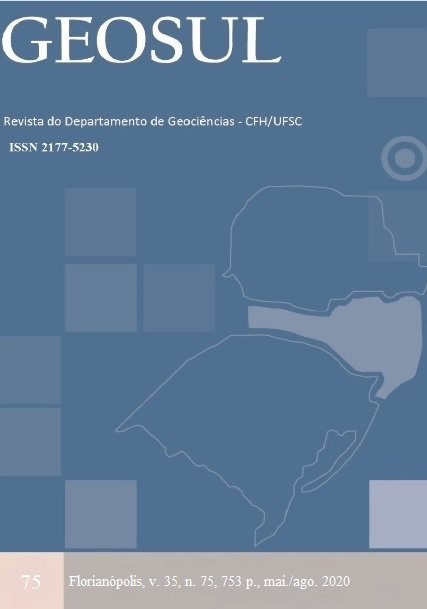Clusters and their adaptation to Global Value Chains
DOI:
https://doi.org/10.5007/1982-5153.2020v35n75p98Abstract
Since 1970, production has fragmented internationally, minimizing costs, shifting the more labor-intensive stages of production to the countries of abundant and cheap labor. Global networks based on transport, telecommunications and information technology are intensifying. Research and development, design, manufacture and distribution, have reshaped production in Global Value Chains (GVCs), forcing industrial districts(IDs)/clusters to adapt, change, reinvest or decline. Thus, via a bibliographic review, we sought to answer the question whether IDs /clusters would lose or gain relevance in globalization. Italian districts changed their specialization from final goods to capital goods, with one third of the enterprises moving to the mechanical industry in related activities, exploring their connections with GVCs, coordinating suppliers, redirecting themselves to high quality products, increasing investments in marketing and brands. In the Brazilian case with the restructuring process, the clusters abandoned the cost reduction strategies and started to innovate, increased the import of intermediate goods and used the outsourcing and relocation of factories to the Brazilian Northeast. Italian districts are increasingly connected to GVCs, while Brazilians are linked to national chains, and only marginally connect to GVCs in governance networks. Thus, IDs /clusters have not lost relevance in globalization, instead industrial districts/clusters sought new ways of producing, making them more flexible, responding to the consumer market, seeking quality through advanced technology, differentiating products, using outsourcing, negotiating with suppliers, manufacturing smaller batches. In this context, the analyzed IDs/clusters survived and are active in the market.References
ASCANI, A.; CRESCENZI, R.; IMMARINO, Simona. Regional Economic Development: A Review. WP1/03 SEARCH WORKING PAPER, Department of Geography and Environment, London School of Economics and Political Science. p. 1-27, January 2012.www.ub.edu/searchproject/wp/content/uploads/2012/02/WP-1.3.pdf.
COSTA, A. B. da. Instituições e competitividade no arranjo calçadista do Vale do Sinos, Análise Econômica, Porto Alegre, ano 27, n. 52, p. 253-283, set. 2009. www.seer.ufrgs.br/AnaliseEconomica/article/download/6965/7462.
DEI OTTATI, G. The Economic Bases of Diffuse Industrialization. In International Studies of Managerial Organizations, volume 21, no 1, pp. 53-57,1991.www.tandfonline.com/doi/abs/.../00208825.1991.1165654. Acesso em: 18 jun. 2019.
DEI OTTATI, G. Marshallian Industrial District: The end of an era or adaptation to the global economy? Italy: University of Florence, 2016. www.cpes.org.uk/dev/wp/content/uploads/.../Gabi_Dei_Ottati.pdf.
GALVÃO, L. A. Distritos industriais: potencial para o desenvolvimento regional e aumento do nível de bem-estar. (Monografia), Curso de Economia, Universidade de Brasília, 1999.
GEREFFI, G. Global Value Chains, Development and Emerging Economies. In: Research statistic and Industrial Policy Branch, Working Paper 18, /2015, Center on Globalization Governance & Competitiveness, Duke University, United. www.unido.org/api/opentext/.../unido-file-9924327.
GIULIANI, E.; RABELLOTTI, R. Italian Industrial Districts Today: Between Decline and Openness to the Global Value Chains. In: DE MARCHI, Valentina; MARIA; Eleonora; GEREFFY, Gary (coords). Local Clusters in Global Value Chains: Linking Actors and Territories Through Manufacturing and Innovation, New York/London, Routledge. p.21-32, 2018.
KNORRINGA, P. & MEYER-STAMER, J. New Dimensions of Local Enterprise Co-operation and Development: From Clusters to Industrial Districts.ATAS Bulletin XI, “New Approaches to Science and Technology Co-operation and Capacity Building, The Hague and Duisburg, 1998. www.pdfs.semanticscholar.org/9b4aa33c5ce1bfb885ee49c90
SEVEGNANI, F.; SACOMANO, J. B. A estratégia de manufatura do setor de malharia retilínea pela análise do processo produtivo – o cluster do circuito de malhas. In: CONGRESSO NACIONAL DE EXCELENCIA EM GESTAO, julho/agosto, 2008, Niterói, RJ, Brasil www.inovarse.org/filebrowser/download/8959.
SILVA, G. S.; GARCIA, R. Fatores de competitividade na indústria de revestimentos cerâmicos: uma análise integrada dos sistemas locais de Criciúma (SC) e Santa Gertrudes (SP). In: XXV ENCONTRO NACIONAL ENGENHARIA DE PRODUÇÃO, 29 out a 01 de nov. de 2005, Porto Alegre, Brasil, ENEGEP/ABEPRO. www.abepro.org.br/biblioteca/enegep2005_enegep0704_0120.pdf
VARGAS, G. T.; ALBERTON, A. R. O quadro recente do cluster cerâmico da Região Sul Catarinense. In: III Encontro de economia catarinense. In: ANAIS DO III ENCONTRO DE ECONOMIA CATARINENSE, Blumenau, 2009. p.1-20. http://www.ensaio.org/quadro-recente-do-cluster-cermico-da-regio-de-cricima.html
ZHANG, L.; SCHIMANSKI, S. CADEIAS GLOBAIS DE VALOR e os países em desenvolvimento. Boletim de Economia Política Internacional (BEPI), nº18, p. 75-94, set./dez. 2014. repositorio.ipea.gov.br/handle/11058/532.
Downloads
Published
Issue
Section
License

Este trabalho está licenciado com uma Licença Creative Commons - Atribuição 4.0 Internacional.


